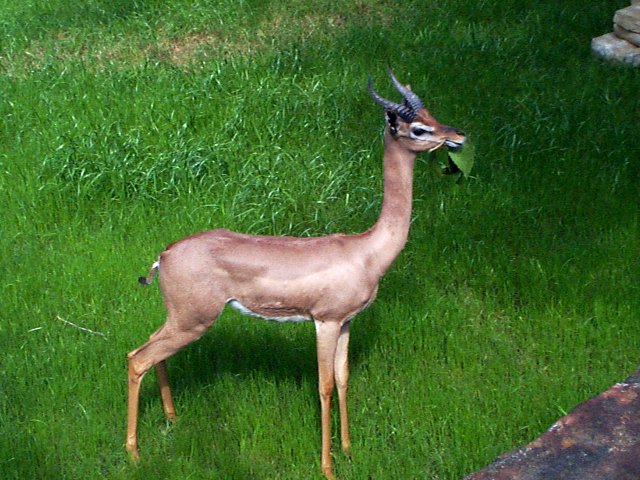| |
|
| Scientific
Name: Litocranius walleri |
|
| GeographicalRange:The
Gerenuk inhabits the woodland forest or the open and dry brushy plains
of |
|
| Habitat: The
Gerenuk is usually found in the desert or dry scrub and savannah.Note
that the Gerenuk has the ability to easily adapt to arid conditions |
|
| Diet
in the Wild: The Gerenuk eats plants but no grass.They have
a preference for leaves of bushes and trees, buds, shoots, fruit, and
flowers.However, even though the Gerenuk inhabits dry area they do not
need to drink much water since they absorb the moister the need form
the plants they eat.Scientists have noticed that Gerenuks that are kept
in captivity have never drunk water. |
|
| Conservation
Status: The Gerenuk has been listened on the IUCN Red list
of Threatened Species since 1996.The major threats for the Gerenuk are
habitat loss, degradation of ongoing agriculture, harvesting and hunting.Their
main predators are wild dogs, cheetahs, leopards, lions, hyena, and
humans, which to decreasing population trend. |
|
| Location
in the Zoo: The Gerenuk is located at the African Hoof Stock Exhibit. |
|
| |
|
| Physical
Description:
The name Gerenuk means “giraffe-necked” in the Somali language.The Gerenuk
is a creature with a long thin neck, and a small head in proportion to
its body, but large, long and slender eyes and ears.There is a ring of
white around the eye.The skinny body is supported by long, slender legs.
The smooth coat is a reddish fawn, with the under parts and front of neck
being white.Along the back is a dark band that reaches down the sides. However,
its short tail is tipped with a tuft of black hair. Horns are found
in males only, which are generally 32-44 cm long.The Gerenuk has a body
length of 140-160 cm, a tail length of 25-35 cm, a shoulder height of
90-105 cm, and a weight of 35-52 kg. |
Social
Organization:
|
| Special Adaptations:
|
|
| Reproductive
Behavior:
Females reach sexual maturity at 1 year and males
at 1.5 years. Females generally conceive every 8-9 month, and usually
give birth to one baby per year, but sometimes a female will have 2
fawns in one year.The gestation period is 6.5 to 7 month.The female
Gerenuk will give birth in a secluded place away form the others in
her group.The baby spends the first couple weeks of its life lying in
the bush while its mother is way feeding.A Gerenuks typical life span
is between 10-12 years.
During the mating ceremony, the male gerenuk marks
his female with the preorbital glands
at the shoulder region and the hindquarters.Consequently, the shape
of the shoulder region of the female is no substitute for twigs or stems. |
The
Animal at the Zoo:
|
| Page
Author: Newsha Jahansouzi
Sources and Links: Grzimek, Bernhard. (2003)Grzimek’s Animal Life Enzycclopedia. New York. Van Nostrand Reinhold Company.pp.431-445. http://www.ultimateungulate.com/Artiodactyla/Litocranius_walleri.html. http://www.thebigzoo/Animals/Gerenuk.asp http://www.abc.lv/thinkquest/tq-entries/16645/wildlife/gerenuk.shtml |
|
| |
|

